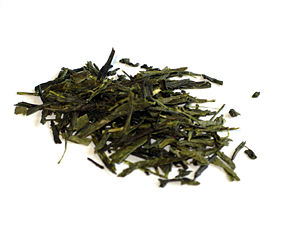Bancha: Difference between revisions
No edit summary |
→Background: Correcting vandalism? Bancha is not 'spelled wrong'. The 'cha' 茶 means 'tea.' |
||
| Line 12: | Line 12: | ||
==Background== |
==Background== |
||
Bancha is harvested from the same tree as ''sencha'' grade, but it is plucked later than ''sencha'' is, giving it a lower market grade. It is considered to be the lowest grade of green tea. There are 22 grades of ''bancha''. Its flavour is unique, it has a stronger organic straw smell. It is often used as a daily consumption of liquid for the [[Macrobiotic diet|Macrobiotic Diet]]. |
|||
==Brewing== |
==Brewing== |
||
Revision as of 17:00, 30 January 2012
| Bancha | |
|---|---|
 | |
| Type | Green |
| Other names | Common Tea |
| Origin | Japan |
| Quick description | More widely available in the West. A late season crop, goes well with food. |
Bancha (番茶) is a Japanese green tea. It is harvested from the second flush of sencha between summer and autumn. (The first flush is harvested for shincha.)
Background
Bancha is harvested from the same tree as sencha grade, but it is plucked later than sencha is, giving it a lower market grade. It is considered to be the lowest grade of green tea. There are 22 grades of bancha. Its flavour is unique, it has a stronger organic straw smell. It is often used as a daily consumption of liquid for the Macrobiotic Diet.
Brewing
Infuse at approximately 80 degrees Celsius (176 degrees Fahrenheit) – this can be achieved by using an electric water boiler with an 80 degrees setting, or by adding 1 quarter of the volume of room temperature water to the boiling water before adding the leaves. Infusing at a higher temperature will cause the tea to taste bitter. Allow the tea to infuse for 30 seconds to 3 minutes.
See also
- Hojicha – often made from bancha
- Japanese tea
